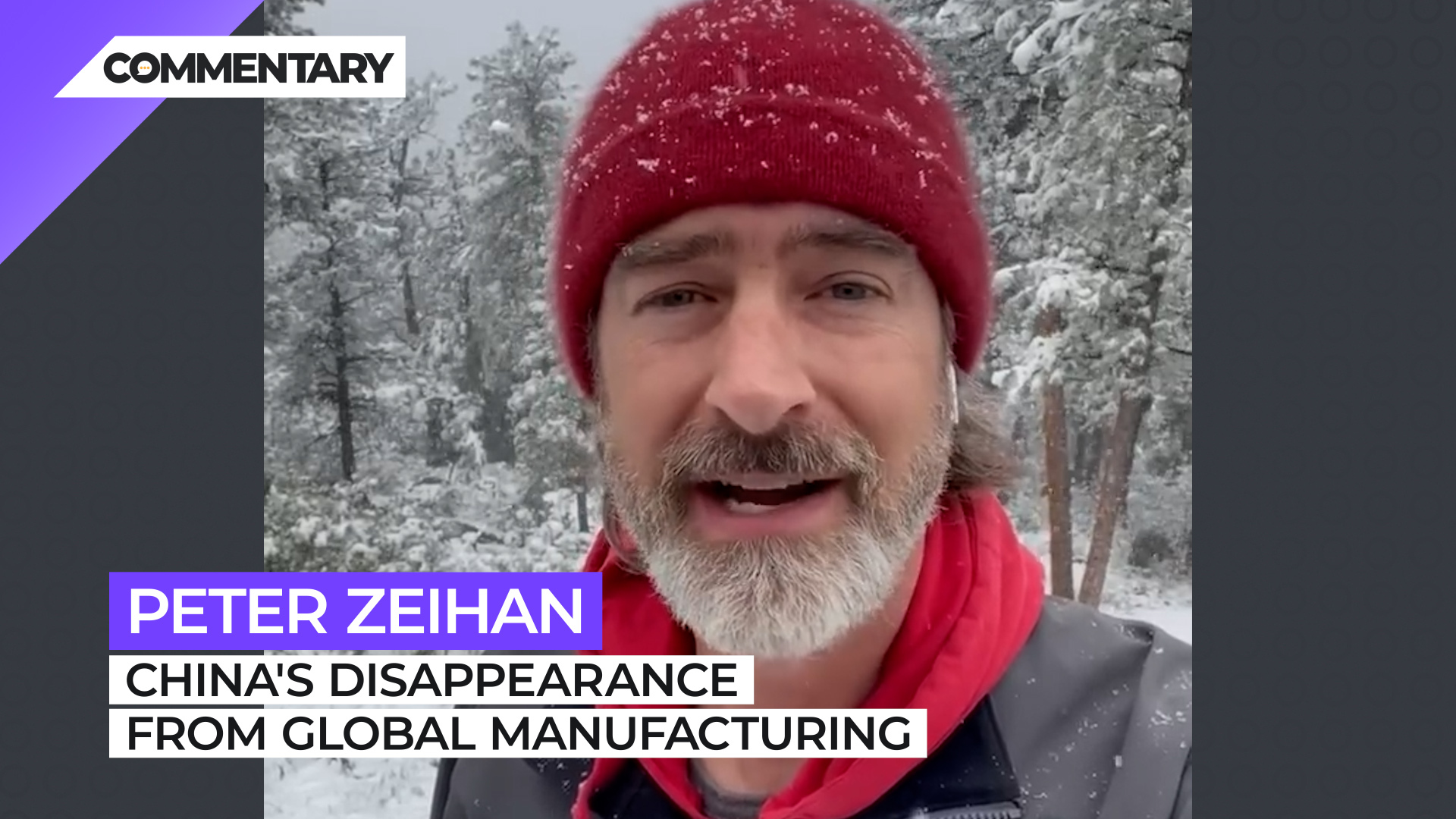
Commentary
-
Our commentary partners will help you reach your own conclusions on complex topics.
Hey everyone, Peter Zeihan here coming to you from Colorado, where it was 74 degrees yesterday, and today we are getting a foot of snow. Today we’re gonna talk about the disappearance of China from global manufacturing.
At issue, is that the Chinese of recently, this week, the last four days, began mass testing for coronavirus in the port city of Tianjin. Tianjin is the single largest port in Northern China; Northern China being where roughly two thirds of the Chinese live. It is a import-export port that focuses on the, on the importing of bulk commodities, such as food stuffs, oil ores, that sort of thing.
Northern China’s a little bit different from Southern China. The Southern China city states, in effect, are all export entrepots and hubs, whereas in Northern China, because more people live there, a lot of the manufacturing is for domestic consumption so they have to bring in raw materials from elsewhere. That doesn’t make Tianjin more or less important than other places, say Shanghai or Guangzhou. It just makes it a different kind of important.
Now what’s going on is that the Chinese are testing food supplies specifically. And that’s how you know that they’re getting ready to lay some blame because there’s no country in the world that thinks you can import COVID on say frozen meat, except for the Chinese. There can be infections on the packaging. That’s certainly true, but we know after two years of COVID that the only way that you might then be able to get COVID is if you shred the materials and then snort them. You can’t get COVID from a surface, but this is what they’re preparing for.
And anytime you do mass testing, like they’re doing in Tianjin now you are going to find cases of Omicron because it is the most infectious disease we have ever dealt with.
Now, if Tianjin goes into lockdown, as seems increasingly likely, that will mean that Tianjin and Beijing are in lockdown in the north, Shanghai in the center, and Guangzhou in the south. And that also means that the three biggest transport and manufacturing hubs in the country, again, Tianjin, Guangzhou and Shanghai, would all be in lockdown of some degree all at the same time.
So we are looking at the majority of Chinese manufacturing for all intents and purposes, being inaccessible to the wider world, or even to the internal Chinese system.
Now I’ve been telling my clients for quite some time that it was only a matter of issue as to how the American Chinese relationship imploded. Could be Trump, could be Biden, could be energy, could be food, could be security, could be trade, could be ethics, could be genocide.
You know, there, it’s a long list, but it appears that COVID ultimately is the one that is winning out.
The Chinese vaccine does not work against COVID. And the Chinese have spent the last two years lambasting the world and lying in the propaganda that they are the only country that has even remotely dealt well with COVID, and they’ve specifically parroted a lot of the crazy theories out there about the Western vaccines that they make you magnetic, or they make you infertile, or whatever else. So they can’t import the Western vaccines at all. They have to wait till they make their own MRNA formula, and there’s no way that’s gonna happen in the next year or two. So lockdowns are the only public health policy they have.
And now the majority of the parts of China that matter are offline. If you’re stuck in manufacturing in China, this is the beginning of the end if it’s not the end already, because as soon as you have an opening, Omicron comes back in, and then you get a closing again, because that is the only tool that the Chinese Communist Party has left. So the question is what’s next? There is a limited option for relocating manufacturing supply chains from China to other parts of the world, most notably North America.
We are experiencing a labor shortage in the United States that will not be let up for at least 20 years. We just know that the Zoomer generation is a relatively small one. They’ve all been born already. They’re feeding into the labor market now, and we know exactly how big our shortage of labor is going to be until the 2040s.
Mexico also is capable of helping, but only to a limited degree because they had a baby bust back in 1995. And their birth rate has been declining ever since. That’s long ago, that is starting to affect their labor markets.
So first mover advantage means a lot, and companies that have decided to ignore the writing on the wall for the last four or five years and just assume that everything was going to go back to how it was before Donald Trump are now being violently disabused of those notions. And they are the late people to the party. And they’re the last ones in line for getting labor to relocate things from China.
All right. That’s everything from me. If you found this interesting, two things, number one, please make a donation to the AFYA foundation, A F Y A foundation.org. They’re providing medical assistance to the people who are in the Ukraine, seeking, or I’m sorry, the, the refugees that are escaping from Ukraine, that’s the group that they’re helping. And then second, if you wanna hear more on this in the future of inflation, we do have a new seminar that we will be doing on June 8th. You can sign up for that at the link below, right next to the AFYA foundation link. All right, that’s it for me? Bye.
Webinar Sign-Up: Inflation: Navigating the New Normal
AFYA Foundation: Amazon Wishlist
-
How could RFK Jr. impact 2024 election?
Many Americans speculated about how a potential RFK, Jr. campaign might impact the 2024 elections. While RFK is neither a Democrat nor a Republican, many of his positions favor Donald Trump’s base over Joe Biden’s, particularly his various conspiracy theories on a wide range of subjects. Straight Arrow News contributor Peter Zeihan says that GOP…
-
Global warming won’t impact Russian-Chinese shipping
The seas above Russia’s northern coastline are too frozen for shipping, but some have wondered whether global warming might change that in the decades to come. If those seas were to become navigable for commercial shipping, new direct routes between Russia and China could theoretically open up. Straight Arrow News contributor Peter Zeihan throws more…
-
Can other nations replicate success of US shale revolution?
The “shale revolution” has provided the United States with a bountiful domestic supply of oil. But extracting oil from shale is a highly technical process, and it is also dependent on specific geological formations. Straight Arrow News contributor Peter Zeihan tackles the question of whether or not other nations might be able to replicate the…
-
Peace between Israel and Iran, at least for now
A series of recent airstrikes between Israel and Iran inflamed fears of a wider regional war erupting in the Middle East. That concern now seems to have paid off, after third-party countries around the world successfully intervened and talked down military hardliners in both Israel and Iran in order to avoid such an outcome. Israel’s…
-
Global internet in a precarious state, but that could be a positive
Over 500 underwater cables span over 870,000 miles worldwide, serving as the foundation of the modern global internet. Despite their critical role in facilitating communication, these cables often go unnoticed, even as the amount of data transmitted through them has surged. So what happens if the cables fail? Straight Arrow News contributor Peter Zeihan contends…
Latest Stories
-
 Getty Images
Getty Images
New CISA cybersecurity measures to fight ransomware raise privacy concerns
-
 Getty Images
Getty Images
How Mexican president’s cheery claims about drug cartels denies reality
-
 AP Images
AP Images
San Diego labeled the 'new epicenter' of the Southern Border crisis
-
 Getty Images
Getty Images
Kim Kardashian attends White House meeting on criminal justice reform
-
 Getty Images
Getty Images
José Andrés honors World Central Kitchen aid workers killed in Gaza
Popular Opinions
-
In addition to the facts, we believe it’s vital to hear perspectives from all sides of the political spectrum.
Latest Opinions
In addition to the facts, we believe it’s vital to hear perspectives from all sides of the political spectrum. We hope these different voices will help you reach your own conclusions.
The opinions published in this section are solely those of the contributors and do not reflect the views of Straight Arrow News.

















Latest Commentary
We know it is important to hear from a diverse range of observers on the complex topics we face and believe our commentary partners will help you reach your own conclusions.
The commentaries published in this section are solely those of the contributors and do not reflect the views of Straight Arrow News.
Peter Zeihan
Geopolitical StrategistGlobal warming won’t impact Russian-Chinese shipping
Can other nations replicate success of US shale revolution?
Peace between Israel and Iran, at least for now
Dr. Frank Luntz
Pollster and Political Analyst‘Take the job seriously’: Why Americans are fed up with Congress
‘If we can shrink it, it will stop growing’: Americans talk debt, deficit
‘I don’t think they care’: Undecided voters explain their reasons
Pete Ricketts
U.S. Senator for Nebraska